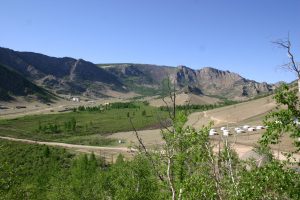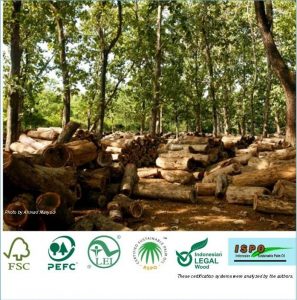Youth Forest Policy Days (YFPD) – 1-3 December 2022
Youth Forest Policy Days (YFPD) – 1-3 December 2022
Guest blog by Juliet Achieng, European Forest Institute
The current global youth (15-24 years) population stands at 1.2 billion translating to 16% of the global population and is expected to rise further by 7% by 2030[1]. The youth have immense potential and can provide innovative solutions to promote development. The need for equipping the youth with knowledge and opportunities that will allow them to thrive and showcase their abilities has been highlighted numerous times. An example of a youth led initiative and first of its kind is the YFPD, a conference-like online event organized by youth for youth to enable the youth community to exchange knowledge and gain more insights about international forest policies. The three-day online event employed diverse formats such as workshops, plenary and parallel sessions and role play game. A living library session focusing on working life provided an opportunity for the participants to be inspired to take action by stories from fellow youth and other professionals in the sector. Through the networking session, the participants had the chance to meet and exchange ideas and experiences with the professionals and participants.

My experience as an IFSA Trainee at IUFRO
My experience as an IFSA Trainee at IUFRO

My name is Mirjana Volarev, and I am from Serbia. I am an environmentalist and a forester with a passion for climate policy. I completed my Bachelor’s degree in Serbia at the Faculty of Forestry, University of Belgrade, and my Master’s degree in Environmental Sciences and Policy at the Central European University in Vienna, Austria.
On Forest Policy and Economics
IUFRO All-Division 9 Meeting at the 125th Anniversary Congress
An Interview with Division 9 Coordinator Daniela Kleinschmit, University of Freiburg, Germany
—– Read more…
Forest transition pathways in Asia
Session F-05(60)
Moderator: Wil De Jong
Wednesday, 26 October 2016, 10:30-12:30 (Room 302B)

Terelj National Park, Mongolia. Photo: Alexander Buck, IUFRO Headquarters
Studies presented in this session examined the dynamic interrelationship between forest transition and economic, social and political changes, and discussed the implications for forest policy.
As we entered the Anthropocene, human influence became increasingly stronger causing great forest decline, particularly from 1920 onwards. Direct drivers of forest decrease include, among others, population growth and agricultural expansion. Read more…
IUFRO Spotlight #39 – Governments Reclaiming Role in Forest Certification
Many governments are reclaiming a role that had been pretty well ceded to ENGOs and other private organizations over the past few decades – state governance of forest certification.
 According to the authors of From governance to government: The strengthened role of state bureaucracies in forest and agricultural certification, this has become more noticeable following the recent rise of state-driven schemes for certifying timber legality as well as palm oil production in places such as Indonesia.
According to the authors of From governance to government: The strengthened role of state bureaucracies in forest and agricultural certification, this has become more noticeable following the recent rise of state-driven schemes for certifying timber legality as well as palm oil production in places such as Indonesia.
Their report sums up findings from a variety of recent studies and suggests, they say, that public administrations are beginning to reclaim certification authority through state-led mandatory schemes as part of a trend away from “transnational private governance to international state-driven governance.” Read more…
National Forest Programmes
The time is right to learn from past experiences and build a second-generation of “National Forest Programmes”
By Alexander Buck, Helga Pülzl and Ewald Rametsteiner
 Since their conception more than two decades ago, national forest programmes (NFP) have become widespread forest policy frameworks internationally. The management of most of the world’s forests is now governed by different types of NFPs to some degree. Hence NFPs present certain governance practices that all countries are interested to have. Yet, the overall picture regarding the impact of NFPs as national forest governance frameworks on sustainable forest management remains ‘fuzzy’. Read more…
Since their conception more than two decades ago, national forest programmes (NFP) have become widespread forest policy frameworks internationally. The management of most of the world’s forests is now governed by different types of NFPs to some degree. Hence NFPs present certain governance practices that all countries are interested to have. Yet, the overall picture regarding the impact of NFPs as national forest governance frameworks on sustainable forest management remains ‘fuzzy’. Read more…
IUFROLAT III Session Highlights: International Forest Governance
International forest governance and its influence on the convergence of forest policy in Latin America
For more information on the IUFRO Task Force on International Forest Governance, visit: http://www.iufro.org/science/task-forces/intl-forest-governance/
Globally, great strides have been made in the last 20 years as to what constitutes responsible forest governance. Yet, frustrations exist at the scale and pace of change. In Latin America, there continues to be a notable gap between ‘rules on paper’ and ‘rules in use’ in most countries, and governance tends to remain firmly based in ‘command-and-control’ approaches established decades ago.
In the session entitled “International Forest Governance and its influence on the convergence of forest policy in Latin America”, leading scholars in this field discussed what political science can do to improve international forest governance in the region through a mix of existing and emerging environmental policy instruments.
Reported cases of “carbon cowboys” deriving indigenous communities from intended benefits from REDD+ have created mistrust and infighting and have raised questions about the usefulness of market-based approaches to environmental problems such as climate change. Yet, the political scientists concluded that – if well designed – market-based instruments such as forest certification or payments for environmental services can help deliver effective policy outcomes. Costa Rica can be cited as a positive example on how new forms and modes of governance have successfully been incorporate into forest policy.
The session also discussed the newly emerging discourse on “rights of nature” in which nature is treated as a ‘subject’ rather than an ‘object’ in environmental legislation. While the notion of collective property rights reflected in this new approach can be seen as a more ethical approach to natural resources, it may however also be motivated by more mundane considerations, such as the intention to bargain for increased financial support from the international community.
Overall, the examples presented in the session indicated the need to incorporate new forms and modes of governance into forest and environmental policy in Latin America. If well-designed, instruments such as legality verification can help form large coalitions of actors and can trigger a “ratchet up” towards better forestry standards in the region.
Presentations in this session:
Policies for promoting sustainable forest management: Convergence of domestic policies and instrument mixes across Latin America (Kathleen McGinley, International Institute of Tropical Forestry, USA)
Carbon cowboys: case studies from Peru (Wil De Jong, Kyoto University Japan)
International forest governance and the rights of nature discourse in South America (David Humphries, UK)
Adaptation of tropical forest management in climate change (Rod Keenan, University of Melbourne, Australia)
Agroforestal systems as an alternative to coca crops in the Chapare region of Bolivia (Eduardo Lopez Rosse, UMSS, Department of Natural Resources, Bolivia)
Factors driving botanical tree diversity in agroforestry systems in Central America (Jenny Ordonez)
Tackling the Complex Relationship Between Forests and Society
Interview with IUFRO Division 9 Coordinator Daniela Kleinschmit
Assoc. Prof. Dr. Daniela Kleinschmit is Coordinator of IUFRO Division 9 “Forest Policy and Economics”. She is heading the unit on forest policy research at the Swedish University of Agricultural Sciences (SLU).

Photo provided by Daniela Kleinschmit
Q: Dr. Kleinschmit, how did you get involved in IUFRO and in how far has your work and career in IUFRO been beneficial for your scientific endeavors?
A.: I got involved in IUFRO about 12 years ago thanks to the supervisor of my PhD thesis, Max Krott. My first IUFRO conference was the World Congress in Kuala Lumpur in 2000. It was fascinating to meet peers from all over the world and exchange ideas, experiences and knowledge. Personal contacts are particularly helpful for developing transnational research projects and writing or organizing publications such as special issues of journals. In addition, a network like IUFRO helps to raise awareness for new triggering questions. Read more…
IUFRO Forest Governance Fact Sheet
PDF document for download
FOREST GOVERNANCE
The current set of international forest governance arrangements is best seen as a complex hybrid mix of international law, soft law, and non-governmental performance-based measures such as international certification schemes and industry codes of conduct. A diverse array of organizations and interest groups, all with different mandates, create the institutional environment for forest policy and governance. All of these actors are dedicated to supporting the different functions of forests, developing and implementing measures designed to protect the forest benefits, and interacting – often in a competitive manner – with each other for political and financial support at different levels. There are an increasing number of governance challenges, such as the demand for bioenergy and legally harvested and produced timber (e.g. EU Timber Regulation on banning illegal timber products from the EU market, to be applied in early 2013). There is clear evidence from research that complex forest problems require synergistic approaches involving a wide range of policy instruments. Read more…
